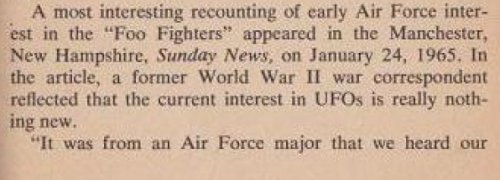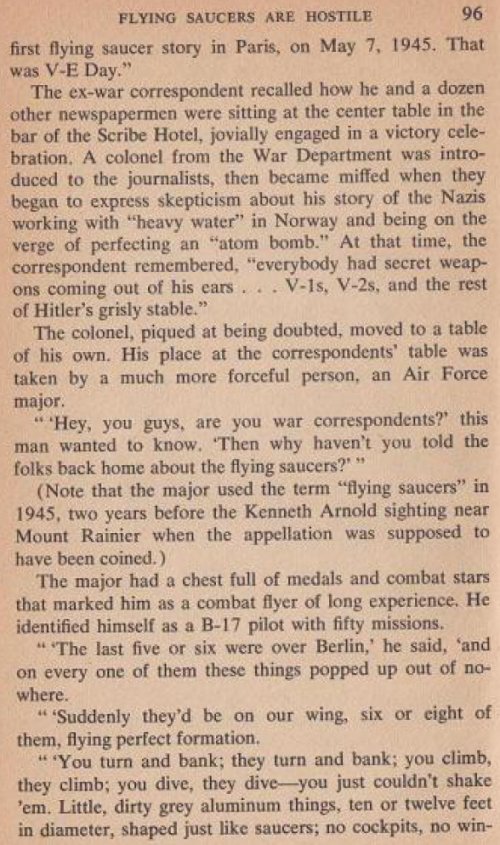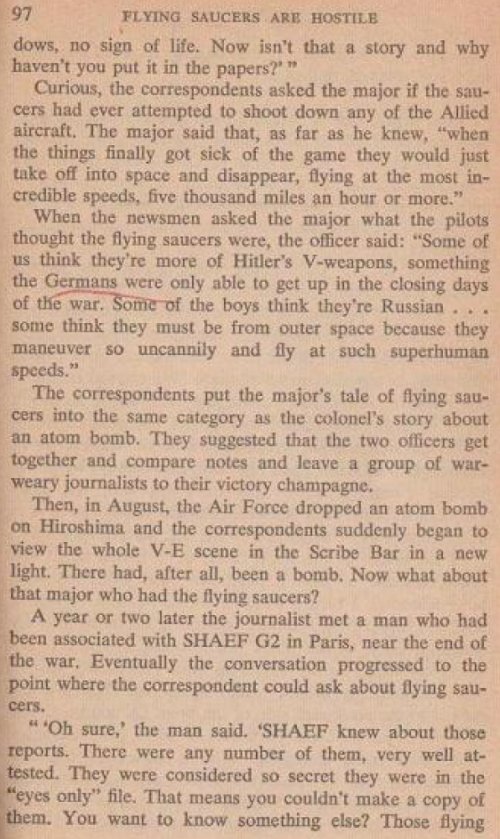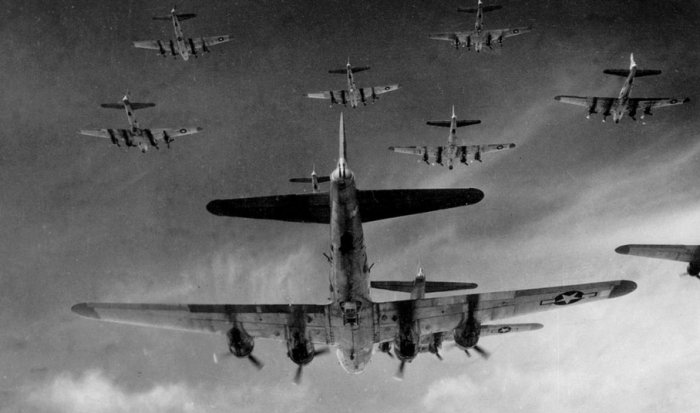ACUFO-1944-00-00-BERLIN-1
In their 1967 book “Flying Saucers Are Hostile”, authors Brad Steiger and Joan Whritenour told about an article in the Manchester, New Hampshire, Sunday News for January 24, 1965; in which a former World War II war correspondent told he heard from an Air Force major his first flying saucer story in Paris, on May 7, 1945.
The ex-war correspondent recalled how he and a dozen other newspapermen were sitting at the center table in the bar of the Scribe Hotel, jovially engaged in a victory celebration, when a Colonel from the War Department was introduced to them, then became miffled when they began to express skepticism about his story of the Nazis working with “heavy water” in Norway and being on the verge of perfecting an “atom bomb.” At that time, the correspondent remembered, “everybody had secret weapons coming out of his ears... V-1s, V-2s, and the rest of Hitler's grisly stable.”
The colonel, piqued at being doubted, moved to a table of his own. His place at the correspondent's table was taken by a much more forceful person, an Air Force major a chest full of medals and combat stars that marked him as a combat flyer of long experience, saying he was a B-17 pilot with 50 missions.
“'Hey, you guys, are you war correspondents?' this man wanted to know. 'Then why haven't you told the folks back home about the flying saucers?'”
“The last five of six were over Berlin,” he said, “... these things popped up out of nowhere”; “Suddenly they'd be on our wing, six or height of them, flying perfect formation.”
The Colonel said: “You turn and bank; they turn and bank; you climb, they climb; you dive, they dive - you just couldn't shake 'em. Little, dirty grey aluminum things, ten or twelve feet in diameter, shaped just like saucers; no cockpits, no windows, no sign of life. Now isn't that a story and why haven't you put it in the papers?'”
Curious, the correspondents asked the major if the saucers have ever attempted to shoot down any of the Allied aircraft. The major said that, as far as he knew, “when the things finally got sick of the game they would just take off into space and disappear, flying at the most incredible speed, five thousand miles an hour or more.”
When the newsmen asked the major what the pilots thought the flying saucers were, the officer said: “Some of us think they're more of Hitler's V-weapons, something the Germans were only able to get up in the closing days of the war. Some of the boys think they're Russian... some think they must be from outer space because they maneuver so uncannily and fly at such superhuman speeds.”
The correspondents put the major's tale of flying saucers into the same category as the colonel's story about an atom bomb.
A year or two later, the journalist met a man who had been associated with SHAEF G2 in Paris, near the end of the war. Eventually, the conversation progressed to the point where the correspondent could ask about flying saucers.
“'Oh sure,' the man said. 'SHAEF knew about those reports. There were any number of them, very well attested. They were considered so secret they were in the “eyes only” file. That means you couldn't make a copy of them. You want to know something else? Those flying saucers were reported, in the closing days of the war, over Tokyo as well as Berlin.'”
Brad Steiger would mention this story again in books he wrote in 1969, 1994, 1999.
| Date: | About 1944 |
|---|---|
| Time: | ? |
| Duration: | ? |
| First known report date: | Day, 1965 |
| Reporting delay: | 2 decades. |
| Country: | Germany |
|---|---|
| State/Department: | Berlin |
| City or place: | Berlin |
| Number of alleged witnesses: | Several |
|---|---|
| Number of known witnesses: | ? |
| Number of named witnesses: | 0 |
| Reporting channel: | Witness talk to journalists, published in the Press. |
|---|---|
| Visibility conditions: | ? |
| UFO observed: | Yes. |
| UFO arrival observed: | ? |
| UFO departure observed: | Yes. |
| UFO action: | Follow maneuvers, leave. |
| Witnesses action: | Escape maneuvers. |
| Photographs: | No. |
| Sketch(s) by witness(es): | No. |
| Sketch(es) approved by witness(es): | No. |
| Witness(es) feelings: | ? |
| Witnesses interpretation: | German or Russian secret weapons, later: extraterrestrial craft. |
| Sensors: |
[X] Visual: Several.
[ ] Airborne radar: [ ] Directional ground radar: [ ] Height finder ground radar: [ ] Photo: [ ] Film/video: [ ] EM Effects: [ ] Failures: [ ] Damages: |
|---|---|
| Hynek: | ? |
| Armed / unarmed: | Armed, 11 7.62 mm machine guns. |
| Reliability 1-3: | 1 |
| Strangeness 1-3: | 3 |
| ACUFO: | Unknown credibility. |
[Ref. brs1:] BRAD STEIGER AND JOAN WHRITENOUR:

|
A most interesting recounting of an early Air Force interest in the “Foo Fighters” appeared in the Manchester, New Hampshire, Sunday News, on January 24, 1965. In the article, a former World War II war correspondent reflected that the current interest in UFOs is really nothing new.
“It was from an Air Force major that we heard our

|
first flying saucer story in Paris, on May 7, 1945. That was V-E Day.”
The ex-war correspondent recalled how he and a dozen other newspapermen were sitting at the center table in the bar of the Scribe Hotel, jovially engaged in a victory celebration. A colonel from the War Department was introduced to the journalists, then became miffled when they began to express skepticism about his story of the Nazis working with “heavy water” in Norway and being on the verge of perfecting an “atom bomb.” At that time, the correspondent remembered, “everybody had secret weapons coming out of his ears... V-1s, V-2s, and the rest of Hitler's grisly stable.”
The colonel, piqued at being doubted, moved to a table of his own. His place at the correspondent's table was taken by a much more forceful person, an Air Force major.
“'Hey, you guys, are you war correspondents?' this man wanted to know. 'Then why haven't you told the folks back home about the flying saucers?'
(Note that the major used the term “flying saucers” in 1945, two years before the Kenneth Arnold sighting near Mount Rainier when the appellation was supposed to have been coined.)
The major had a chest full of medals and combat stars that marked him as a combat flyier of long experience. He identified himself as a B-17 pilot with fifty missions.
“'The last five of six were over Berlin,' he said, 'and on evey one of them these things popped up out of nowhere.
“'Suddenly they'd be on our wing, six or height of them, flying perfect formation.
“'You turn and bank; they turn and bank; you climb, they climb; you dive, they dive - you just couldn't shake 'em. Little, dirty grey aluminum things, ten or twelve feet in diameter, shaped just like saucers; no cockpits, no win-

|
dows, no sign of life. Now isn't that a story and why haven't you put it in the papers?'”
Curious, the correspondents asked the major if the saucers have ever attempted to shoot down any of the Allied aircraft. The major said that, as far as he knew, “when the things finally got sick of the game they would just take off into space and disappear, flying at the most incredible speed, five thousand miles an hour or more.”
When the newsmen asked the major what the pilots thought the flying saucers were, the officer said: “Some of us think they're more of Hitler's V-weapons, something the Germans were only able to get up in the closing days of the war. Some of the boys think they're Russian... some think they must be from outer space because they maneuver so uncannily and fly at such superhuman speeds.”
The correspondents put the major's tale of flying saucers into the same category as the colonel's story about an atom bomb. They suggested that the two officers get together and compare notes and leave a group of war weary journalists to their victory champagne.
Then, in August, the Air force dropped an atom bomb on Hiroshima and the correspondents suddenly began to view the whole V-E scene in the Scribe Bar in a news light. There had, after all, been a bomb. Now what about that major who had the flying saucers?
A year or two later, the journalist met a man who had been associated with SHAEF G2 in Paris, near the end of the war. Eventually, the conversation progressed to the point where the correspondent could ask about flying saucers.
“'Oh sure,' the man said. 'SHAEF knew about those reports. There were any number of them, very well attested. They were considered so secret they were in the “eyes only” file. That means you couldn't make a copy of them. You want to know something else? Those flying

|
saucers were reported, in the closing days of the war, over Tokyo as well as Berlin.'”
[Ref. bsr2:] BRAD STEIGER AND JOAN WHRITENOUR:
In Flying Saucers Are Hostile, we quote a former war correspondent's interview with an Air Force major, who on V-E Day, told a number of journalists about Allied experience with what he termed “flying saucers.” It is interesting to note that this B-17 pilot with fifty missions under his belt used the term “flying saucers” two years before the Kenneth Arnold sighting near Mount Rainier when the appellation was supposed to have been coined.
“Suddenly they'd be on our wing, six or eight of them, flying perfect formation,” the major told the skeptical newsman. “You turn and bank, they turn and bank; you climb, they climb; you dive, they dive - you just couldn't shake 'em. Little, dirty grey aluminum things, ten or twelve feet in diameter, shaped just like saucers; no cockpits, no windows, no sign of life... when the things got tired of the game, they would just take off into space and disappear, flying at the most incredible speeds, five thousand miles an hour or more.”
Although the war correspondent was skeptical of the major's story, he later discussed “flying saucers” with a man who had been the SHAEF G2 in Paris near the end of the war. This man told him that SHAEF had known all about the pilots' reports of flying saucers, “They were considered so secret they were in the “eyes only” file...”
[Ref. lgs1:] LOREN GROSS:
On May 7, 1945 it was V-E day. In Paris a group of war correspondents were...
“...sitting at the center table in the bar of the Scribe Hotel, jovially engaged in a victory celebration. A colonel from the War Department was introduced to the journalists, he then became miffed when they began to express skepticism about his story of the Nazis working with 'heavy water' in Norway and being on the verge of perfecting an 'atom bomb'... The colonel, piqued at being doubted, moved to a table of his own. His place at the correspondent's table was taken by a much forceful person, an Air Force major.
“Hey, you guys, are you war correspondents?' this man wanted to know. 'Then why haven't you told the folks back home about the flying saucers?'
The major had a chest full of medals and combat stars that marked him as a B-17 pilot with fifty missions.
'The last five or six were over Berlin,' he said, 'and on every one of them these things popped up out of nowhere. Suddenly they'd be on our wing, six or eight of them, flying perfect formation.'
'You turn and bank; they turn and bank; you climb; they climb, you dive, they dive - you just couldn't shake 'em. Little, dirty grey aluminum things, ten or twelve feet in diameter, shaped just like saucers; no cockpits, no windows, no sign of life. Now isn't that a story and why haven't you put it in the papers?'
Curious, the correspondents asked the major if the saucers had ever attempted to shoot down any of the Allied aircraft. The major said that, as far as he knew, 'when the things finally got sick of the game, they would just take off into space and disappear, flying at the most incredible speeds, five thousand miles an hour or more.'
When the newsmen asked the major what the pilots thought the flying saucers were, the officer said: 'Some of us think they're more of Hitler's V-weapons, something the Germans were only able to get up in the closing days of the war. Some of the boys think they're Russian... some think they must be from outer space because they maneuver so uncannily and fly at such superhuman speeds.'
The correspondents put major's tale of flying saucers into category as the colonel's story about an atom bomb. They suggested that the two officers get together and compare notes and leave a group of war-weary journalists to their victory champagne.”
[Ref. bsr3:] BRAD STEIGER:
But what if there could have been primitive prototypes of terrestrial flying saucers flown as early as 1942 by an ultra secret group of Nazi scientists working under extraterrestrial guidance? These initial Nazi UFOs may still have been basically low-altitude craft - and while they may have been capable of flying distances far greater than any conventional aircraft, the antigravity devices were not yet perfected to the point where they could circle the globe indefinitely.
A U.S. Army Air Corps major who claimed over fifty missions as a B-17 pilot told of encountering “Foo Fighters” over Berlin circa 1944:
“These things [unknown circular craft] popped up out of nowhere. Suddenly they'd be on our wing, six or eight of them, flying perfect formation.
“You'd turn and bank; they'd turn and bank. You would climb; they would climb. You dive; they dive. You just couldn't shake them. Little, dirty, gray aluminum things, ten or twelve feet in diameter, shaped just like saucers; no cockpits, no windows, no sign of life.”
Did they ever try to shoot down any Allied craft?
“As far as I know, when the things got sick of the cat-and-mouse game, they would just take off into space and disappear, flying at the most incredible speeds - maybe 5,000 miles per hour or more!”
What do you think the craft were?
“Some of the guys thought that they were more of Hitler's V-weapons, something the Nazis were only able to get up in the closing days of the war. Some of the boys thought they were Russian. Some even believed the things must have been from outer space because they maneuvered so uncannily and flew at such superhuman speeds.”
A man who had been a “belly gunner” on several bombing raids over Germany told us of his encounters with the strange, saucer-shaped aerial objects:
“I suppose that I felt especially nervous and vulnerable because I sometimes seemed so all alone in my little capsule under the bomber. Anyway, these things, 'Foo Fighters' we called them most of the time, would zip right up beside our 'flying fortress' like they came from out of nowhere. Usually, they would just pace us, like they were observing us. Sometimes I felt that I could feel eyes inside the craft, watching my every move; but I could-never see into the things or figure out how they saw anything.
“I personally saw the objects half a dozen or more times. I thought at first that they were some new kind of buzz bomb that the Nazi supermen had dreamed up, and I expected them to attack us and try to blast us out of the skies. I never heard of any of the things making any aggressive move toward any Allied aircraft.”
An officer in Paris recalled reports of unidentified flying objects that had harassed Allied bombing missions during the last days of World War II:
“There were any number of them, very well attested. They were considered so secret they were in the 'eyes only' file. That means you couldn't make a copy of the papers.
“You want to know something else? Those flying saucer-shaped craft were reported in the closing days of the war over Tokyo, as well as over Berlin.”
[Ref. pre1:] PHILIP R. RIFE:
A second type of UFO encountered with some frequency by Allied fliers in Europe resembled a small saucer. Here's how an American bomber pilot described a typical encounter with this phenomenon: “Suddenly, they'd be on our wing, six or eight of them, flying perfect formation. You turn and bank, they turn and bank. You climb, they climb. You dive, they dive. You just couldn't shake them. (They were) little, dirty gray aluminum things, 10 or 12 feet in diameter, shaped just like saucers. (There were) no cockpits, no windows, no sign of life. When the things got tired of the game, they would just take off into space and disappear, flying at the most incredible speeds - 5,000 miles an hour or more”. (281)
The source was described as: "281. Gen. H.H. Arnold papers, USAF Historical Records Center, Maxwell AFB, AL 282."
[Ref. jrr1:] JOHN B. RINGER:
One B-17 pilot, a veteran of more than fifty missions, remembered encountering the Foo Fighters on many occasions. “Suddenly, they'd be on our wing, six or eight of them, flying in perfect formation. You turn and bank, they turn and bank; you climb, they climb; you dive, they dive. You just couldn't shake them. Little, dirty-grey aluminum things, ten or twelve feet in diameter, shaped just like saucers - no cockpits, no windows, no sign of life. When the things finally got sick of the game, they would just take off into space and disappear, flying at the most incredible speeds.” 3
The source “3” is detailed as “Steiger, Brad, UFO Odyssey. Ballantine Publishing Group, New York, NY. 1999.”
The U.S. B-17 “Flying Fortress” was a heavy bomber fitted with five 7.62 machine guns for its defense against enemy fighter planes.

|

|
The Scribe hotel did exist and still exists, at 1 Rue Scribe, 75009 Paris.
The “SHAEF” was the “Supreme Headquarters Allied Expeditionary Force”, in north-western Europe, from the end of 1943 to the end of World War II. Dwight David Eisenhower was its general in chief. “G2” stood for Intelligence.
Brad Steiger, pseudonym of Eugene E. Olson, (1936 - 2018), was a prolific American author, who published numerous books on the paranormal, UFOs, prehistoric mysteries, vampires, ghosts, occultism, spirituality, as well as biographies of movie stars including Greta Garbo, Judy Garland and Rudolph Valentino.
The story that he tells here and repeats from book to book would be verifiable first in the sense that it would have been published in the press; unfortunately I have not been able to find an archive of the indicated newspaper so far.
If the story did appear in the indicated newspaper, it nevertheless remains difficult to verify since the names of the officers making the indicated remarks are not given. I have no indication that they made these comments in other circumstances.
Unknown credibility.
* = Source is available to me.
? = Source I am told about but could not get so far. Help needed.
| Main author: | Patrick Gross |
|---|---|
| Contributors: | None |
| Reviewers: | None |
| Editor: | Patrick Gross |
| Version: | Create/changed by: | Date: | Description: |
|---|---|---|---|
| 0.1 | Patrick Gross | April 12, 2024 | Creation, [bsr1], [bsr2], [bsr3], [jrr1]. |
| 1.0 | Patrick Gross | April 12, 2024 | First published. |
| 1.1 | Patrick Gross | April 28, 2024 | Addition [lgs1]. |
| 1.2 | Patrick Gross | July 27, 2024 | Addition [pre1]. |